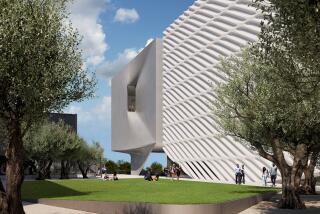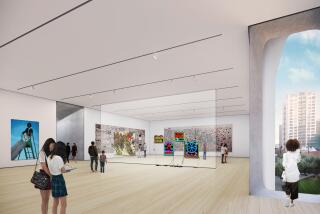O say, you can see flag better
- Share via
WASHINGTON -- Inspired by the American flag flying after the 1814 British attack on Baltimore’s Fort McHenry, Francis Scott Key wrote “O! say can you see” and penned the words that would become the national anthem.
But at America’s most popular history museum, the presentation of the famous flag -- the Star-Spangled Banner -- hasn’t exactly taken the breath away. For decades, it hung in a darkened, enclosed room near the entrance of the National Museum of American History, covered by a screen that opened for a few minutes every hour. Some tourists simply walked by the exhibit -- failing to notice the banner that helped shape the young country’s identity, museum director Brent Glass said.
Museum officials are promising a much larger, more dramatic flag exhibit when the history museum reopens next year after an $85-million renovation. Now midway through this massive project, the museum has been knocking down walls, removing clutter, rethinking history and planning overhauled exhibits, including the gloomy banner space.
“I think it’s the most comprehensive rethinking of the museum, clearly since we opened in 1964,” said Glass, who joined the Smithsonian five years ago after more than a decade of directing Pennsylvania’s state history program.
Many of the changes will address a 2002 report from a commission appointed by the Board of Regents that sharply criticized the museum for its mystifying layout and its less-than-inclusive presentation of history. The commission noted that the clutter, darkness and confined spaces made the Smithsonian’s nickname “America’s attic” a good fit.
It was “a glorious hodgepodge of things and themes,” said Richard Norton Smith, a prominent presidential historian and member of the commission. “To the nonspecialist who walked in the door, it was unnecessarily confusing.”
When the museum reopens, visitors will get an awe-inspiring view of the Star-Spangled Banner.
Workers have been slicing through five floors of the building to create a new skylight and atrium that will be the core of the new exhibition space. The flag gallery will be the centerpiece, and it will be protected from sunlight, with special lighting to depict “the dawn’s early light.”
The flag will rest on a specially designed aluminum and steel table, sealed in a glass case with reduced lighting and oxygen levels to prevent deterioration or fire. Glass said it was the largest known exhibit case.
Construction costs for the new gallery make up about $19 million of the total project.
Museum officials are also trying to do more to draw visitors to the 30-by-42-foot flag’s history. In the past, there had been little to engage visitors beyond a label at the banner’s base and the periodic playing of the national anthem over nearby speakers. Now, the exhibit will be rich with details on the Battle of Baltimore and Francis Scott Key’s poem, which became the nation’s song. The first stanza will be printed behind the flag.
Beyond the banner exhibit and other major architectural changes, planners are hoping to engage visitors by adding interactive displays, costumed interpreters and a more ethnically inclusive view of history in upcoming years. Visitors might be able to handle reproductions of historic objects, and use high-tech displays to discover links between the past and future.
More to Read
The biggest entertainment stories
Get our big stories about Hollywood, film, television, music, arts, culture and more right in your inbox as soon as they publish.
You may occasionally receive promotional content from the Los Angeles Times.










